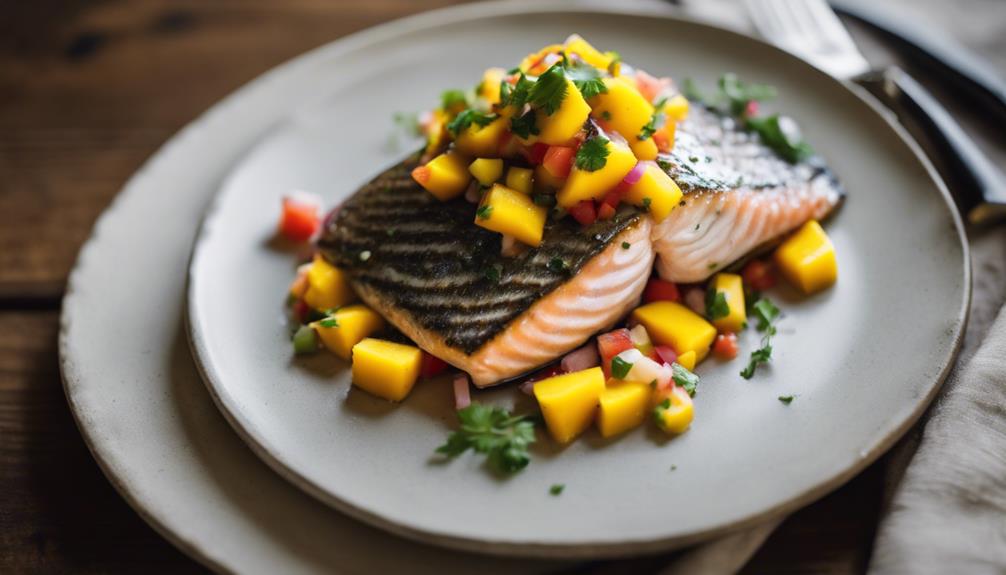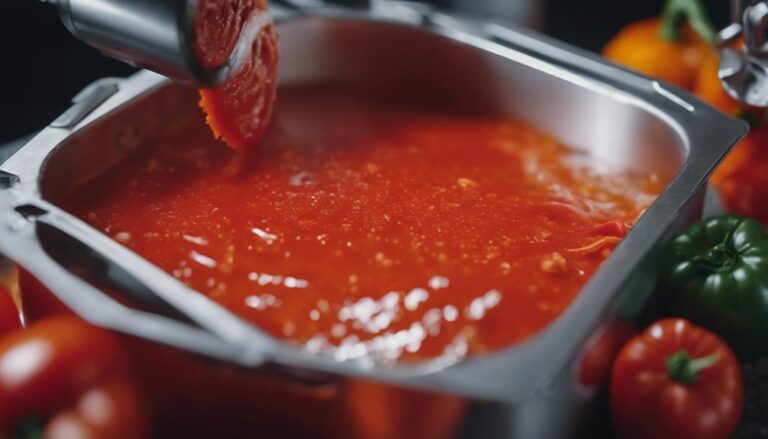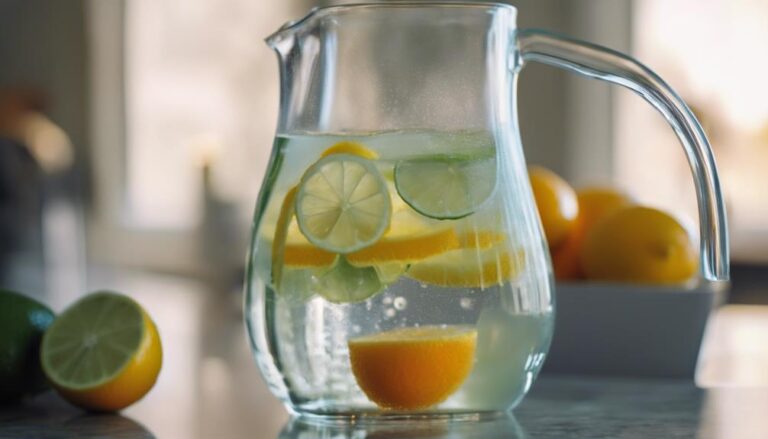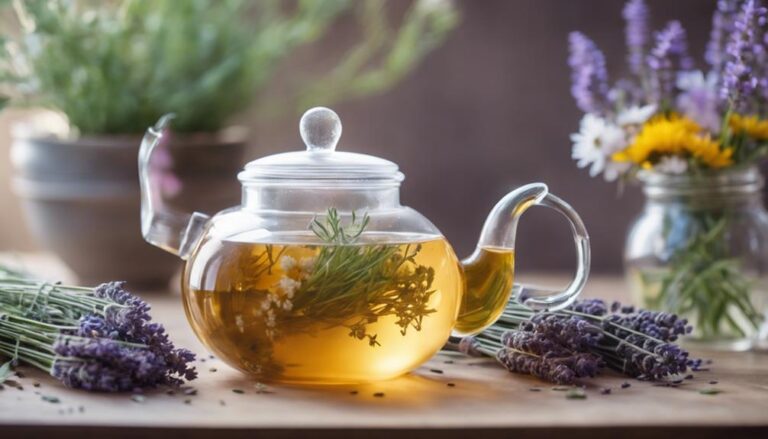Sous Vide Rainbow Trout With Mango Salsa
Get ready to savor Sous Vide Rainbow Trout with Mango Salsa. Cook the trout sous vide to perfection, ensuring precise temperature control for juicy, tender fish. Prepare a zesty mango salsa for a burst of tropical flavor that pairs perfectly with the delicate trout. The high-tech sous vide method guarantees even cooking and moisture retention, highlighting the natural taste of the trout. Elevate your culinary skills by combining the vibrant colors and fresh flavors in this delightful dish. Uncover the secrets to creating a gourmet meal that tantalizes your taste buds and impresses your guests.
What You Will Learn Here
- Sous vide cooking ensures precise temperature control for perfectly cooked trout.
- Mango salsa adds a refreshing and tropical flavor to the dish.
- Sous vide method enhances moisture retention and flavor infusion in the trout.
- Rainbow trout's delicate texture pairs well with the vibrant mango salsa.
- Culinary experience combines tender sous vide trout with zesty mango salsa for a delightful meal.
Trout Farming Origins
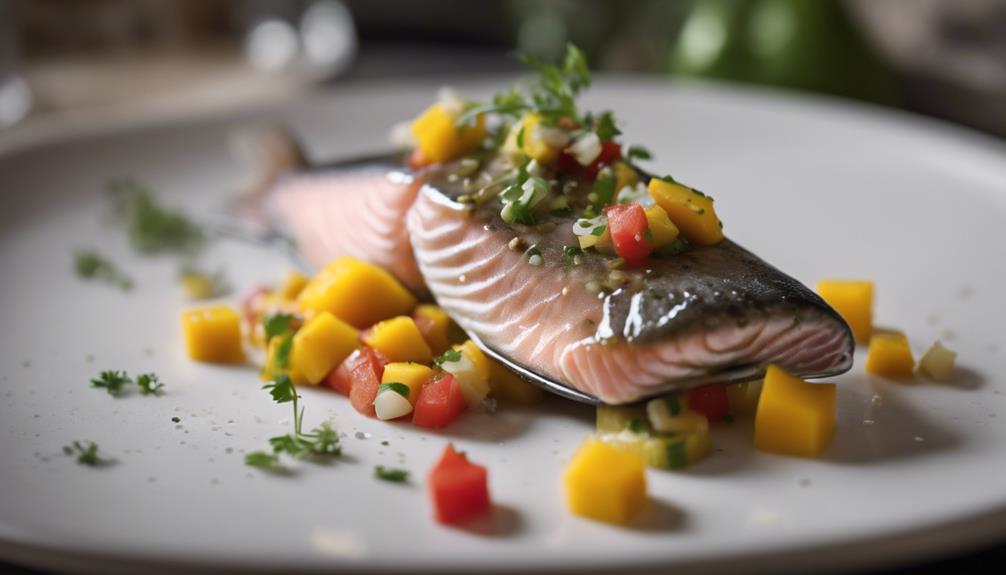
Trout farming has a rich history that dates back centuries, evolving into the sustainable practices seen today. Understanding the origins of trout farming allows for a deeper appreciation of the industry's commitment to environmentally friendly methods.
Exploring the environmental impact of trout farming sheds light on the importance of responsible aquaculture practices.
Trout Farming History
Originating in ancient times, the practice of farming trout has evolved greatly over the centuries. Trout farming techniques have seen significant advancements due to the progress in aquaculture. In the early days, trout were mainly caught in the wild. However, as demand increased, humans began to rear trout in controlled environments.
Aquaculture played an important role in this shift, allowing for the development of sustainable trout farming practices. The ancient Romans were among the first to experiment with artificial breeding of trout. Over time, different trout farming methods emerged, such as pond farming and raceway systems. These methods helped increase production and secure a more consistent supply of trout.
With the introduction of modern technology, trout farming has become more efficient and environmentally friendly. Advances in water filtration, nutrition, and disease prevention have greatly improved the industry's sustainability. Today, trout farming continues to evolve, incorporating new innovations to meet the growing demand for this popular fish.
Sustainable Farming Practices
As the demand for trout increased, sustainable farming practices emerged, revolutionizing the way trout were reared and harvested.
Aquaculture practices played an essential role in developing sustainable solutions for fish farming, addressing concerns about the environmental impact.
Trout farming shifted towards more environmentally friendly methods, such as recirculating aquaculture systems that recycle water and reduce waste discharge.
These innovations not only improved the efficiency of trout production but also minimized the ecological footprint of fish farming operations.
Environmental Impact of Farming
With the rise of commercial fish farming, the early practices of trout cultivation inadvertently set the stage for the subsequent environmental impacts observed today. Trout farming, a form of aquaculture, initially aimed to meet the growing demand for seafood. However, as this industry expanded, concerns about its environmental footprint emerged.
One significant issue is the carbon footprint associated with trout farming. The energy-intensive process of maintaining water quality, regulating temperatures, and feeding the fish contributes to greenhouse gas emissions. Efforts are being made to reduce this impact through innovations in energy-efficient systems and sustainable practices.
Another critical aspect is water usage and conservation. Trout farming requires large quantities of water for fish rearing, waste management, and maintaining favorable conditions. This high water demand can strain local water sources and ecosystems. To address this, farms are implementing water-recirculation systems and best practices to minimize water consumption and protect freshwater resources for the future.
Trout Fillets and Fresh Herbs
For the freshest flavor, select trout fillets that are vibrant in color and aromatic fresh herbs to complement the delicate taste. When preparing your trout fillets with fresh herbs, consider the following tips:
- Choose Bright Green Herbs: Opt for herbs like dill, parsley, cilantro, or chives to add a burst of color and freshness to your dish.
- Finely Chop the Herbs: To evenly distribute the herb flavors, finely chop them before adding them to your trout fillets.
- Gently Rub Herbs on the Fillets: Before cooking, gently rub the fresh herbs onto the trout fillets to infuse them with flavor.
- Add Herbs at the Right Time: For the best taste, add the fresh herbs towards the end of the cooking process to preserve their aroma and essence.
Trout Fillet Varieties
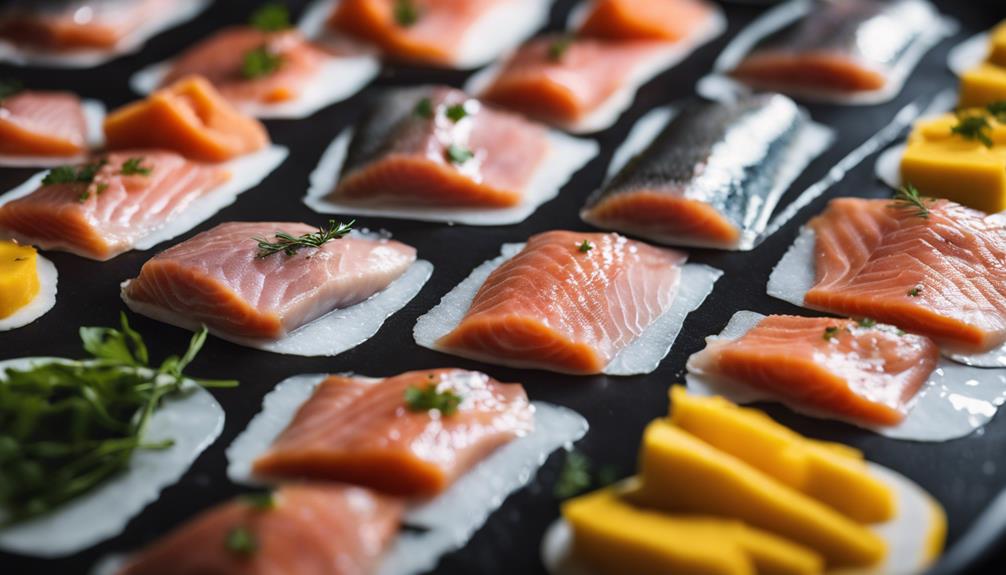
When choosing trout fillets for your recipes, consider the variety available such as Sous Vide Trout With Citrus, Mango Glazed Trout, and Honey Glazed Trout. These different types of trout fillets offer unique flavors that can elevate your dishes to new levels of taste.
Experiment with the various trout fillet options to find the perfect match for your culinary creations.
Sous Vide Trout With Citrus
To enhance the flavor of your trout fillet, consider infusing it with the zesty essence of citrus through sous vide cooking. Citrus-marinated sous vide trout offers a burst of freshness that complements the delicate texture of the fish.
Here's how to achieve this delectable dish:
- Start by seasoning your trout fillet with a blend of salt, pepper, and citrus zest for a vibrant flavor profile.
- Place the seasoned fillet in a vacuum-sealed bag with a splash of citrus juice to enhance the marinade's infusion.
- Set your sous vide precision cooker to the desired temperature, typically around 130°F (54°C) for a perfect, tender result.
- Let the trout cook in the citrus-infused bath for about 30-45 minutes, allowing the flavors to meld together while maintaining the fish's moisture and tenderness.
Mango Glazed Trout Recipe
Infusing your trout fillet with a luscious mango glaze elevates its flavor profile to new heights, creating a tantalizing culinary experience. When preparing a mango glazed trout, consider the following:
- Tropical Fruit Pairing: The sweet and tangy flavors of mango complement the delicate taste of trout, offering an invigorating twist to your dish.
- Sous Vide Techniques: Utilize sous vide cooking methods for precise temperature control, ensuring your trout is cooked to perfection without losing its moisture or tenderness.
- Flavor Balance: The mango glaze strikes a harmonious balance between the richness of the trout and the fruity sweetness of the mango, enhancing the overall taste sensation.
- Cooking Precision: With sous vide, you can achieve exact cooking times, allowing the flavors of the mango glaze to infuse seamlessly into the trout fillet, resulting in a mouthwatering dish that's sure to impress your taste buds.
Honey Glazed Trout Recipe
Looking to explore a delectable twist on trout fillet varieties? Honey glazed trout offers a sweet and savory flavor profile that will elevate your next meal. Whether you prefer grilling or baking your trout fillets, this recipe is sure to impress. Here's how to make honey glazed trout:
- Preparation: Begin by preheating your grill or oven to the desired temperature for either grilling or baking the trout fillets.
- Seasoning: Season the trout fillets with salt, pepper, and any additional herbs or spices of your choice to enhance the flavor.
- Glazing: Brush a generous amount of honey glaze over the seasoned trout fillets, ensuring they're evenly coated for a delicious caramelized finish.
- Cooking: Place the trout fillets on the grill or in the oven and cook until the fish is flaky and the glaze has caramelized to perfection.
Enjoy the delightful combination of sweet honey glaze and tender trout fillets with this easy and flavorful recipe.
Sous Vide Temperature Control
When using sous vide cooking for your rainbow trout, remember the importance of precise temperature settings for best results.
Consistent heat distribution throughout the cooking process guarantees that your fish is cooked evenly.
This accuracy in temperature control leads to perfectly cooked trout every time.
Precise Temperature Settings
For precise temperature control when cooking sous vide, make sure that you accurately set the desired temperature on your immersion circulator. Temperature precision is vital in sous vide cooking to achieve the perfect doneness and texture of your food. By setting the immersion circulator to the exact temperature required by your recipe, you guarantee that your rainbow trout cooks evenly and retains its moisture and flavor.
Different cooking techniques may require specific temperature settings. For example, cooking fish like rainbow trout at a lower temperature around 120°F (49°C) can result in a delicate and tender texture, while a higher temperature around 140°F (60°C) may produce a firmer texture. Understanding the relationship between temperature and texture is essential in sous vide cooking. Experimenting with different temperature settings can help you discover your preferred doneness for various dishes.
Consistent Heat Distribution
To ensure consistent heat distribution in sous vide cooking, maintain precise temperature control throughout the entire cooking process. Temperature consistency is vital when using sous vide cooking techniques. The sous vide machine circulates water at a constant temperature, ensuring heat distribution is even across your food. This precise control allows your rainbow trout to cook evenly from edge to center, resulting in a perfectly cooked dish.
When heat distribution is consistent, cooking becomes more reliable and predictable. By keeping the water temperature steady, you create an environment where your trout cooks gently and uniformly. This controlled heat distribution is one of the key benefits of sous vide cooking techniques. It eliminates the risk of overcooking or undercooking your fish, giving you the confidence to achieve consistent results every time you cook.
Mastering heat distribution through precise temperature control is essential for successful sous vide cooking. Understanding how temperature consistency impacts the cooking process will help you elevate your culinary skills and create delicious dishes like sous vide rainbow trout with mango salsa.
Accurate Cooking Results
Maintain precise temperature control in sous vide cooking to achieve accurate cooking results, particularly focusing on Sous Vide Temperature Control for best outcomes. Temperature accuracy is essential in sous vide cooking as it guarantees that your food is cooked to perfection. By setting the water bath at the exact temperature required for your recipe, you can achieve consistent and precise results every time. This precision also impacts cooking time, as different temperatures dictate how quickly your food cooks.
When you maintain the correct temperature, flavor infusion and texture retention are optimized. The controlled heat allows flavors to meld together slowly, resulting in a more intense and well-rounded taste. Additionally, the gentle cooking process preserves the natural textures of the ingredients, keeping them tender and juicy. Whether you're cooking delicate fish like rainbow trout or tougher cuts of meat, precise temperature control in sous vide cooking guarantees delicious and consistent results that will impress your taste buds.
Final Thoughts
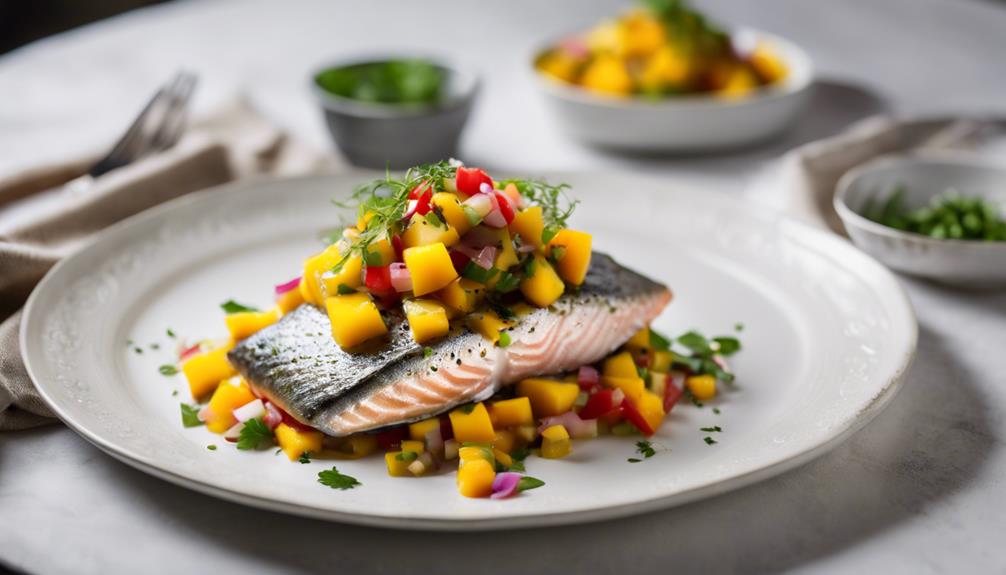
In conclusion, reflecting on the culinary experience of preparing and savoring this Sous Vide Rainbow Trout With Mango Salsa may evoke a sense of satisfaction and delight. The benefits of sous vide cooking shine through in the perfectly cooked trout, where flavor retention is maximized, resulting in a tender and moist fish that bursts with taste.
Pairing the trout with the vibrant mango salsa enhances the dish, adding a freshness appeal that complements the delicate flavors of the fish. The combination of the sous vide method and the zesty salsa creates a harmonious balance of textures and flavors that tantalize the taste buds.
As you take the last bite, you may find yourself impressed by the simplicity of the cooking process and the complex flavors that emerge from this dish. Whether you're a seasoned chef or a beginner in the kitchen, this sous vide rainbow trout with mango salsa is sure to leave a lasting impression with its exquisite taste and elegant presentation.
Frequently Asked Questions
Can Rainbow Trout Be Cooked Using Traditional Methods Instead of Sous Vide?
Yes, rainbow trout can be cooked using traditional methods. You can try pan searing or grilling for a delicious flavor. Baking or broiling also work well. Experiment with different techniques to find your favorite way to cook it.
Are There Any Alternatives to Mango Salsa for Serving With Trout?
When serving trout, consider trying alternatives to mango salsa like peach relish or avocado guacamole for a fresh twist. Pineapple salsa or tomato chutney can also complement the fish beautifully with their unique flavors.
How Can I Prevent the Trout Fillets From Becoming Overcooked?
To prevent overcooking, focus on temperature control and precise cooking time. Utilize the benefits of sous vide for flavor retention. Guarantee the fillets are sealed properly and monitor the cooking process closely to achieve perfectly cooked trout.
Can I Use Frozen Trout Fillets for This Recipe?
Yes, you can use frozen trout fillets for this recipe. However, fresh trout may yield a better result. For sous vide cooking, make sure your fillets are properly thawed before starting. Follow sous vide tips to maintain precise temperature and cooking times.
Is Sous Vide Cooking Suitable for Other Types of Fish Besides Trout?
Yes, sous vide cooking is suitable for a variety of fish. You can try sous vide salmon for a tender result or experiment with grilled halibut for a smoky flavor. Both options offer delicious and versatile fish dishes.
Conclusion
To sum up, sous vide rainbow trout with mango salsa is a delectable and flavorful dish that can be easily prepared at home.
By utilizing precise temperature control and fresh herbs, you can create a restaurant-quality meal that's sure to impress your family and friends.
Experiment with different fillet varieties to discover your favorite combination of flavors.
Whether you're a seasoned chef or a novice in the kitchen, this recipe is a great way to elevate your culinary skills.
